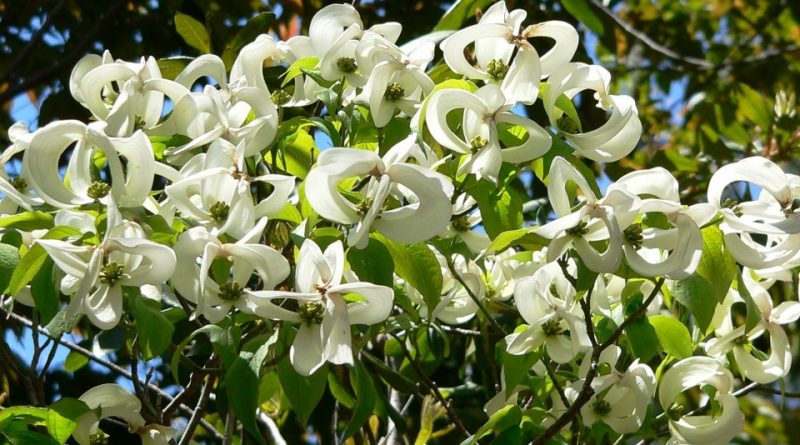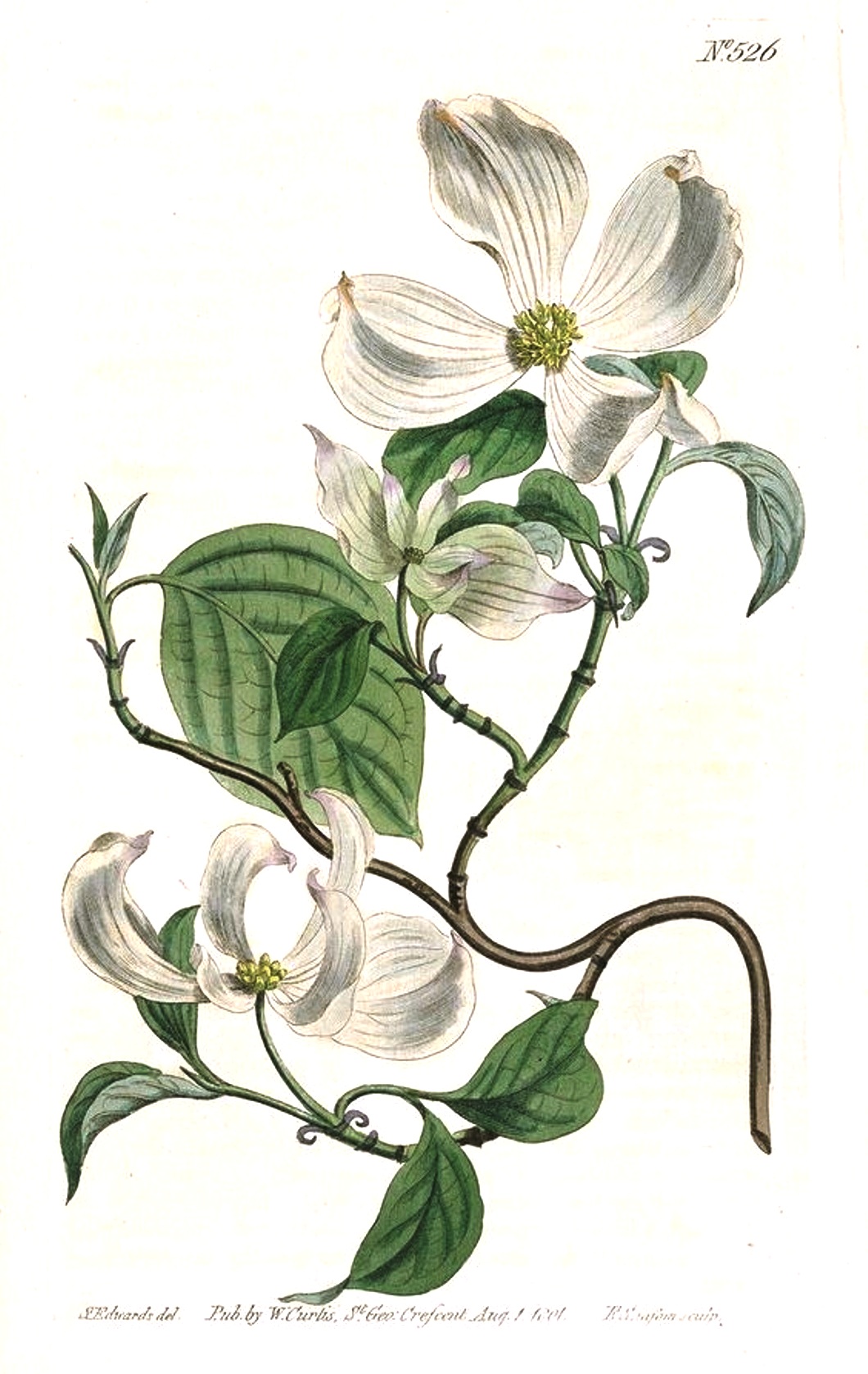Cornus florida
Cornus florida
The Flowering Dogwood (Cornus florida L.) is an arboreal species belonging to the Cornaceae family.
Systematics –
From the systematic point of view it belongs to the Eukaryota Domain, Kingdom Plantae, Subarign Tracheobionta, Superdivisione Spermatophyta, Magnoliophyta Division, Magnoliopsida Class, Sottoclasse Rosidae, Order Cornales, Family Cornaceae and therefore to the Genus Cornus and to the Species C. florida.
The terms are synonymous:
– Benthamia florida (L.) Nakai;
– Benthamidia florida (L.) Spach;
– Cornus candidissima Mill .;
– Cynoxylon floridum (L.) Britton & Shafer;
– Swida candidissima (Mill.) Small;
– Cornus urbiniana Rose.
Etymology –
The term Cornus comes from the Indo-European root kar being hard, passed to the Latin cornus corno, to emphasize the hard and robust wood.
The specific Florida epithet refers to its presumed origin or diffusion in Florida, USA.
Geographic Distribution and Habitat –
Flowering Dogwood is a plant native to Maine, eastern North America, and northern Mexico. An endemic population once stretched from the southern coast of Maine in the south to northern Florida and west to the Mississippi River.
It is widespread in southern Ontario, Illinois, Kansas, southern Florida, Texas, and Mexico. It is the state tree of Missouri and Virginia.
Its natural habitat is that of the forest edges and often on dry ridges.
Description –
The flowering dogwood is a small deciduous tree that grows up to 10 m in height, often with a broad crown, especially when ripe, with a trunk diameter of up to 30 cm.
The leaves are opposite, simple, ovate, 6-13 cm long and 4-6 cm broad, with an apparently entire margin (actually very finely toothed when viewed with magnification); these turn red-brown in autumn.
The flowers are small and inconspicuous, with four 4 mm long greenish-yellow bracts. they are grouped (in a number around 20) in a dense rounded inflorescence in the shape of an umbrella, or flower head, 1–2 cm in diameter. The flower head is surrounded by four large and showy white, pink or red “petals” (actually bracts) and each bract is 3 cm long and 2.5 cm wide, rounded and often with a distinct notch at the apex. The flowers are hermaphrodites.
They generally bloom in early April in the southern part of their range, until late April or early May in northern and high altitude areas.
The fruit is a cluster of two to ten separate drupes, each 10-15 mm long and about 8 mm wide, which ripen in late summer and take on a bright red color as they fall, or occasionally yellow with a pinkish redness.
The maximum life span of this tree is around 80 years.
Cultivation –
The flowering dogwood prefers moist and acid soils in areas with afternoon half-light, but good morning sun.
It does not grow well when exposed to intense heat sources such as adjacent parking lots or air conditioning compressors. It also has a low salinity tolerance. The pH range of the soil can vary from 5 to 9 and the preferred pH is between 6.0 and 7.0, on well-drained soils.
In urban and suburban environments, care should be taken not to inflict damage with mowers to the trunk or roots, as this increases the tree’s susceptibility to disease and pest pressure.
This plant was placed on the list of endangered species in Ontario. In regions where anthracnose dogwood is a problem, homeowners and public land managers are encouraged to learn about the symptoms and inspect trees frequently. Selecting healthy, disease-free planting plants is essential, and transplanting trees from the forest should be avoided.
Dead wood and leaves should be pruned and completely removed and destroyed every year. The plants should be watered weekly during drought, with watering done in the morning, avoiding wetting the foliage.
If necessary, registered fungicides can be used by following the local technical assistance services.
As far as propagation is concerned, these plants, in spring or early summer, can be multiplied by practicing semi-woody cuttings; in spring it is also possible to propagate the plants by sowing, using the seeds of the previous year. The best method for multiplication is that of layering, but it is possible to obtain new shrubs using the new offshoots.
The cornus florida is one of the most loved and coveted ornamental trees by gardeners. It is particularly appreciated for its elegant bearing and for its spectacular and elegant flowering. Given its relatively small size, as well as in the ground, it can be grown in large pots on balconies and terraces. To obtain a long-lived and vigorous specimen, some specific cultivation conditions and a good dose of experience are necessary.
Flowering dogwood is widely cultivated throughout the temperate world.
While most wild trees have white bracts, some select cultivars of this tree also have pink bracts, some even almost true red.
Regarding the selected cultivars we remember:
– Amerika Touch-O-Pink – with large bracts, tinged with pink; large leaves; good disease resistance;
– Appalachian Spring – with large white bracts; red autumn foliage; resistant to anthracosis dogwood;
– Autumn Gold – has white bracts with autumn yellow color;
– Barton: large white bracts; blooms at an early age; resistant to canker and powdery mildew;
– Bay Beauty – double white bracts; resists heat and drought; good for the deep south of its range;
– Cherokee Daybreak – white bract; vigorous with variegated leaves;
– Cape Cherokee – red bracts;
– Cherokee Brave – Even more red than the Cherokee Chief, smaller bracts but dark red in color; constantly resistant to powdery mildew;
– Cherokee Princess – vigorous white bracts, industry standard for white flowers;
– Cherokee Sunset – purplish red bracts; variegated foliage;
– Gulf Coast Pink – the best pink flowering dogwood in Florida – only in the northern part;
– Hohman’s Gold – features white bracts and variegated foliage;
– Jean’s Appalachian Snow – large white bracts overlaid with green flowers; very resistant to powdery mildew;
– Karen’s Appalachian Blush- delicate white bracts edged with pink; some resistance to powdery mildew;
– Kay’s Appalachian Mist – creamy and stiff white bracts; red autumn foliage; good resistance to powdery mildew;
– Plena – double white bracts; anthracnose – resistant;
– Purple Glory – red bracts; purple foliage; anthracnose-resistant but susceptible to stem cancer;
– Weaver White – large white flowers; large leaves; candlestick shape; good in north central Florida.
Customs and Traditions –
Cornus florida is commonly planted as an ornamental plant in residential and public areas due to its showy bracts and interesting bark structure.
Native Americans used the bark and roots in a remedy for malaria; a red dye was also extracted from the roots. This plant has been used in the production of inks, scarlet dyes and as a substitute for quinine. Hard, dense wood has been used for products such as golf club heads, clubs, wooden rake teeth, tool handles, jeweler boxes, and butcher blocks.
Cornus florida is the state tree and flower of Virginia, the state tree of Missouri and the state flower of North Carolina.
It was once used to treat dogs with mange.
The red berries are not edible, despite some discordant rumors.
In 1915, forty dogwood saplings were donated by the United States to Japan in the 1912-15 flower exchange between Tokyo and Washington, while the flowering cherry trees survived the subsequent harsh relations of these two countries and are the main feature of the National Cherry Blossom Festival; all of the dogwood trees in Tokyo died except the one that was planted in a high school of agriculture. In 2012, the United States sent 3,000 dogwood saplings to Japan to commemorate the centennial of the Washington cherry trees, donated to the United States by Japan in 1912.
From an ecological point of view, Cornus florida is an important food source for dozens of bird species, which then distribute the seeds. It is also a plant that hosts the larvae of several varieties of lepidoptera, including Eudeilinia herminiata, dogwood thiatyris, Antispila cornifoliella, pink moth, great arch moth, pecan bark borer, dogwood borer, rosacea, the diamond-backed epinotia moth, spring moths, cecropia moths and Aglais Io.
The Cornus florida, although not poisonous to humans, has extremely acid fruits and an unpleasant taste.
Preparation Method –
Flowering Dogwood was once used by Native Americans who used the bark and roots to prepare remedies for malaria.
Furthermore, in the past, a red dye was also extracted from the roots. In fact, this plant has been used in the production of inks, scarlet dyes and as a substitute for quinine.
Guido Bissanti
Sources
– Acta Plantarum – Flora of the Italian Regions.
– Wikipedia, the free encyclopedia.
– Useful Tropical Plants Database.
– Conti F., Abbate G., Alessandrini A., Blasi C. (edited by), 2005. An annotated checklist of the Italian vascular flora, Palombi Editore.
– Pignatti S., 1982. Flora of Italy, Edagricole, Bologna.
– Treben M., 2000. Health from the Lord’s Pharmacy, Advice and experiences with medicinal herbs, Ennsthaler Editore.
Warning: Pharmaceutical applications and alimurgical uses are indicated for informational purposes only, they do not represent in any way a medical prescription; therefore no responsibility is taken for their use for curative, aesthetic or food purposes.


